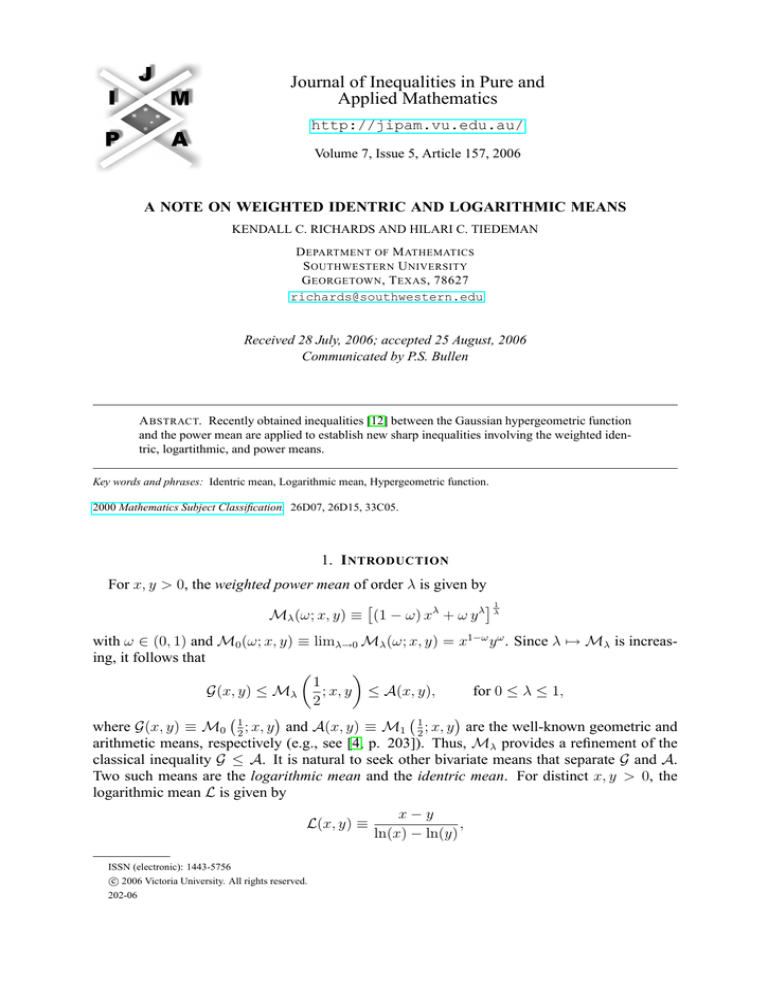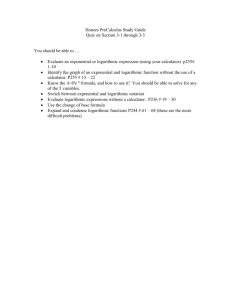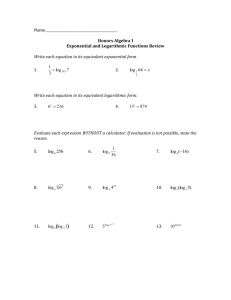
Journal of Inequalities in Pure and
Applied Mathematics
http://jipam.vu.edu.au/
Volume 7, Issue 5, Article 157, 2006
A NOTE ON WEIGHTED IDENTRIC AND LOGARITHMIC MEANS
KENDALL C. RICHARDS AND HILARI C. TIEDEMAN
D EPARTMENT OF M ATHEMATICS
S OUTHWESTERN U NIVERSITY
G EORGETOWN , T EXAS , 78627
richards@southwestern.edu
Received 28 July, 2006; accepted 25 August, 2006
Communicated by P.S. Bullen
A BSTRACT. Recently obtained inequalities [12] between the Gaussian hypergeometric function
and the power mean are applied to establish new sharp inequalities involving the weighted identric, logartithmic, and power means.
Key words and phrases: Identric mean, Logarithmic mean, Hypergeometric function.
2000 Mathematics Subject Classification. 26D07, 26D15, 33C05.
1. I NTRODUCTION
For x, y > 0, the weighted power mean of order λ is given by
1
Mλ (ω; x, y) ≡ (1 − ω) xλ + ω y λ λ
with ω ∈ (0, 1) and M0 (ω; x, y) ≡ limλ→0 Mλ (ω; x, y) = x1−ω y ω . Since λ 7→ Mλ is increasing, it follows that
1
G(x, y) ≤ Mλ
; x, y ≤ A(x, y),
for 0 ≤ λ ≤ 1,
2
where G(x, y) ≡ M0 12 ; x, y and A(x, y) ≡ M1 12 ; x, y are the well-known geometric and
arithmetic means, respectively (e.g., see [4, p. 203]). Thus, Mλ provides a refinement of the
classical inequality G ≤ A. It is natural to seek other bivariate means that separate G and A.
Two such means are the logarithmic mean and the identric mean. For distinct x, y > 0, the
logarithmic mean L is given by
L(x, y) ≡
ISSN (electronic): 1443-5756
c 2006 Victoria University. All rights reserved.
202-06
x−y
,
ln(x) − ln(y)
2
K ENDALL C. R ICHARDS AND H ILARI C. T IEDEMAN
and L(x, x) ≡ x. The integral representation
Z 1
−1
−1
(1.1)
L(1, 1 − r) =
(1 − rt) dt
,
r<1
0
is due to Carlson [6]. Similarly, the identric mean I is defined by
1
1 xx x−y
,
I(x, y) ≡
e yy
I(x, x) ≡ x, and has the integral representation
Z 1
(1.2)
I(1, 1 − r) = exp
ln(1 − rt) dt ,
r < 1.
0
The inequality
G ≤ L ≤ A was refined by Carlson [6] who showed that L(x,
y) ≤
M1/2 21 ; x, y . Lin [8] then sharpened this by proving L(x, y) ≤ M1/3 12 ; x, y . Shortly
thereafter, Stolarsky [14] introduced the generalized logarithmic mean which has since come to
bear his name. These and other efforts (e.g., [11, 15]) led to many interesting results, including
the following well-known inequalities:
(1.3)
G ≤ L ≤ M1/3 ≤ M2/3 ≤ I ≤ A,
where each is evaluated at (x, y), and the power means have equal weights ω = 1 − ω = 1/2. It
also should be noted that the indicated orders of the power means in (1.3), namely 1/3 and 2/3,
are sharp. Following the work of Leach and Sholander [7], Páles [10] gave a complete ordering
of the general Stolarsky mean which provides an elegant generalization of (1.3). (For a more
complete discussion of inequalites involving means, see [4].)
2. M AIN R ESULTS
Our main objective is to present a generalization of (1.3) using the weighted logarithmic and
identric means. Moreover, sharp power mean bounds are provided. This can be accomplished
using the Gaussian hypergeometric function 2 F1 which is given by
2 F1 (α, β; γ; r)
≡
∞
X
(α)n (β)n
n=0
(γ)n n!
rn ,
|r| < 1,
where (α)n is the Pochhammer symbol defined by (α)0 = 1, (α)1 = α, and (α)n+1 = (α)n (α +
n), for n ∈ N. For γ > β > 0, 2 F1 has the following integral representation due to Euler (see
[2]):
Z 1
Γ(γ)
tβ−1 (1 − t)γ−β−1 (1 − rt)−α dt,
2 F1 (α, β; γ; r) =
Γ(γ − β)Γ(β) 0
R∞
which, by continuation, extends the domain of 2 F1 to all r < 1. Here Γ(z) ≡ 0 tz−1 e−t dt for
z > 0; Γ(n) = (n − 1)! for n ∈ N. Inequalities relating the Gaussian hypergeometric function
to various means have been widely studied (see [1, 2, 3, 5, 12]). Of particular use here is the
hypergeometric mean of order a discussed by Carlson in [5] and defined by
a1
Z 1
Γ(c)
c ω−1
c ω 0 −1
a
Ha (ω; c; x, y) ≡
t
(1 − t)
(x(1 − t) + yt) dt
Γ(c ω 0 )Γ(c ω) 0
h
y i a1
= x · 2 F1 −a, c ω; c; 1 −
x
J. Inequal. Pure and Appl. Math., 7(5) Art. 157, 2006
http://jipam.vu.edu.au/
W EIGHTED L OGARITHMIC AND I DENTRIC M EANS
3
with the parameter c > 0 and weights ω, ω 0 > 0 satisfying ω+ω 0 = 1. Clearly Ha (ω; c; ρx, ρy) =
ρ Ha (ω; c; x, y) for ρ > 0, so Ha is homogeneous. Euler’s integral representation and (1.1) together yield
−1
Z
1
Γ(2) 1
−1
H−1
; 2; 1, 1 − r =
(1 − rt) dt
= L(1, 1 − r).
2
Γ(1)2 0
Multiplying by x, with r = 1 − y/x, and applying homogeneity yields H−1 21 ; 2; x, y =
L(x, y). This naturally leads to the weighted logarithmic mean L̂ which is defined as
L̂(ω; c; x, y) ≡ H−1 (ω; c; x, y).
Weighted logarithmic means have been discussed by Pittenger [11] and Neuman [9], among
others (see also [4, p. 391-392]). Similarly, the weighted identric mean Î is given by
Î(ω; c; x, y) ≡ H0 (ω; c; x, y) ≡ lim Ha (ω; c; x, y)
a→0
Z 1
Γ(c)
c ω−1
c ω 0 −1
= exp
t
(1 − t)
ln[x(1 − t) + yt] dt
Γ(c ω 0 )Γ(c ω) 0
(see [5], [13]). Thus, Î 21 ; 2; x, y = I(x, y).
The following theorem establishes inequalities between the power means and the weighted
identric and logarithmic means.
Theorem 2.1. Suppose x > y > 0 and c ≥ 1.
If 0 < ω ≤ 1/2, then the weighted identric mean Î satisfies
(2.1)
c (ω; x, y) ≤ Î(ω; c; x, y).
M c+1
If 1/2 ≤ ω < 1 and c ≤ 3, then the weighted logarithmic mean L̂ satisfies
(2.2)
L̂(ω; c; x, y) ≤ M c−1 (ω; x, y) .
c+1
Moreover, the power mean orders c/(c + 1) and (c − 1)/(c + 1) are sharp.
A key step in the proof will be an application of the following recently obtained result:
Proposition 2.2. [12] Suppose 1 ≥ a and c > b > 0. If c ≥ max{1 − 2a, 2b}, then
1
b
(2.3)
Mλ
; 1, 1 − r ≤ [2 F1 (−a, b; c; r)] a for all r ∈ (0, 1),
c
if and only if λ ≤ (a + c)/(1 + c). If −a ≤ c ≤ min{1 − 2a, 2b}, then the inequality in (2.3)
reverses if and only if λ ≥ (a + c)/(1 + c).
Proof of Theorem 2.1. Suppose x > y > 0, c ≥ 1, ω ∈ (0, 1) and define b ≡ c ω with r ≡
1 − y/x ∈ (0, 1). If ω ≤ 1/2 and a ∈ (0, 1), it follows that c ≥ max{1 − 2a, 2b}. Hence the
previous proposition implies
(2.4)
1
M a+c (ω; 1, 1 − r) ≤ [2 F1 (−a, b; c; r)] a .
1+c
Taking the limit of both sides of (2.4) as a → 0+ yields
(2.5)
c (ω; 1, 1 − r) ≤ H (ω; c; 1, 1 − r).
M c+1
0
Now suppose ω ≥ 1/2 and c ≤ 3. Then c ≤ 2b and −a = 1 ≤ c ≤ 3 = 1 − 2a for a = −1.
Thus
(2.6)
H−1 (ω; c; 1, 1 − r) = [2 F1 (1, b; c; r)]−1 ≤ M c−1 (ω; 1, 1 − r) ,
J. Inequal. Pure and Appl. Math., 7(5) Art. 157, 2006
c+1
http://jipam.vu.edu.au/
4
K ENDALL C. R ICHARDS AND H ILARI C. T IEDEMAN
again by the above proposition. Multiplying both sides of the inequalities in (2.5) and (2.6) by
x and applying homogeneity yields the desired results.
In the case that ω = 1/2, we have
Corollary 2.3. If x, y > 0, 1 ≤ c ≤ 3, and ω = 1/2 then
(2.7)
c
H−2 ≤ H−1 ≤ M c−1 ≤ M c+1
≤ H0 ≤ H1 .
c+1
Moreover, (c − 1)/(c + 1) and c/(c + 1) are sharp. If c = 2, then (2.7) reduces to (1.3).
Proof. Suppose x > y > 0, 1 ≤ c ≤ 3, and ω = 1/2. Hence (2.2) and (2.1), together with the
fact that λ 7→ Mλ is increasing, imply
1
1
1
1
c
; x, y ≤ H0
; c; x, y .
; x, y ≤ M c+1
H−1
; c; x, y ≤ M c−1
c+1
2
2
2
2
The remaining inequalities follow directly from Carlson’s observation [5] that a 7→ Ha is increasing. The condition that x > y can be relaxed by noting that Ha is symmetric in (x, y)
when ω = 1/2. This symmetry can be seen by making the substitution s = 1 − t in Euler’s
integral representation:
a
Z 1
1
Γ(c)
Ha
; c; x, y =
[t(1 − t)]c/2−1 ((1 − t)x + ty)a dt
2
Γ(c/2)2 0
Z 1
Γ(c)
=
[(1 − s)s]c/2−1 (sx + (1 − s)y)a ds
Γ(c/2)2 0
a
1
= Ha
; c; y, x .
2
c
Finally, note that M c−1 = M 1 and M c+1
= M 2 when c = 2. Also,
3
3
c+1
−2
1
1
; 2; 1, 1 − r
= 2 F1 (2, 1; 2; r) =
,
H−2
2
1−r
1
for |r| < 1. It follows that H−2 21 ; 2; x, y = (xy) 2 = G(x, y). Likewise, H1 12 ; 2; x, y =
x(1 − (1 − y/x)/2) = A(x, y). Thus (2.7) implies (1.3).
R EFERENCES
[1] H. ALZER AND S.-L. QIU, Monotonicity theorems and inequalities for the complete elliptic integrals, J. Comp. Appl. Math., 172 (2004), 289–312.
[2] G.E. ANDREWS, R. ASKEY, AND R. ROY, Special Functions, Cambridge University Press, Cambridge, 1999.
[3] R.W. BARNARD, K. PEARCE, AND K.C. RICHARDS, An inequality involving the generalized
hypergeometric function and the arc length of an ellipse, SIAM J. Math. Anal., 31 (2000), 693–699.
[4] P.S. BULLEN Handbook of Means and Their Inequalities, Kluwer Academic Publishers, Dordrecht, 2003.
[5] B.C. CARLSON, Some inequalities for hypergeometric functions, Proc. Amer. Math. Soc., 16
(1966), 32–39.
[6] B.C. CARLSON, The logarithmic mean, Amer. Math. Monthly, 79 (1972), 615–618.
[7] E.B. LEACH AND M.C. SHOLANDER, Multi-variate extended mean values, J. Math. Anal.
Appl., 104 (1984), 390–407.
[8] T.P. LIN, The power and the logarithmic mean, Amer. Math. Monthly, 81 (1974), 271–281.
J. Inequal. Pure and Appl. Math., 7(5) Art. 157, 2006
http://jipam.vu.edu.au/
W EIGHTED L OGARITHMIC AND I DENTRIC M EANS
5
[9] E. NEUMANN, The weighted logarithmic mean, J. Math. Anal. Appl., 188 (1994) 885–900.
[10] Z. PÁLES, Inequalities for differences of powers, J. Math. Anal. Appl., 131 (1988), 271–281.
[11] A.O. PITTENGER, The logarithmic mean in n variables, Amer. Math. Monthly, 92 (1985), 99–104.
[12] K.C. RICHARDS, Sharp power mean bounds for the Gaussian hypergeometric function, J. Math.
Anal. Appl., 308 (2005), 303–313.
[13] J. SÁNDOR AND T. TRIF, A new refinement of the Ky Fan inequality, Math. Ineq. Appl., 2 (1999),
529–533.
[14] K. STOLARSKY, Generalizations of the logarithmic means, Math. Mag., 48 (1975), 87–92.
[15] K. STOLARSKY, The power and generalized logarithmic means, Amer. Math. Monthly, 87 (1980),
545–548.
J. Inequal. Pure and Appl. Math., 7(5) Art. 157, 2006
http://jipam.vu.edu.au/





